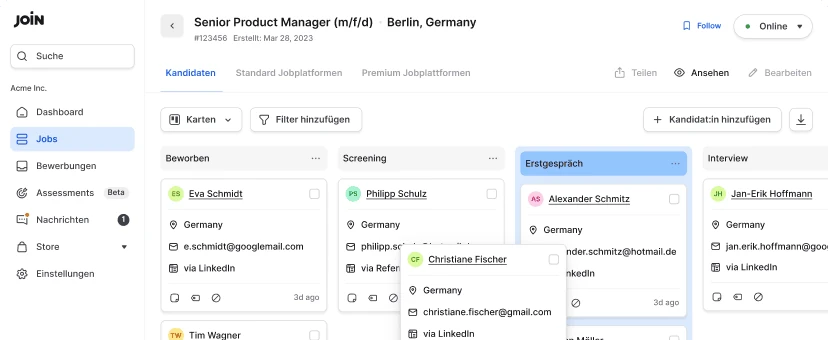Fair shortlisting made easy
The most complicated process of a candidate selection procedure is, potentially, the creation of a shortlist. The shortlisting process can be confusing and, above all, it’s not always that fair.
Table of contents
This is due to the fact that sifting through and examining the application documents requires a lot of time and concentration. And the different designs of the documents make it almost impossible to capture all the important details in a unified, structured way.
In this article, we will explain how you can set up a well-structured and fair hiring, selection, and shortlisting process in order to filter out top talent in a targeted way. We will walk you through the following points:
What is shortlisting?
Shortlisting refers to the process of weeding out unqualified applications from the overall pool of applicants (longlist) for an advertised position, using appropriate selection methods to produce a narrower pool of candidates (shortlist).
The shortlist only includes candidates who meet the relevant key criteria for a position. Candidates who make it onto the shortlist are invited to a first interview as the next step of the multi-stage selection process. For further information, please see our glossary entry on shortlisting.
The 4 most common problems with shortlisting
Not only is the creation of unfair shortlists a problem for candidates, but it can also lead to companies disadvantaging themselves. They might end up weeding out the best talent for the job or, in some cases, their (even unintentional) subjectivity can have serious legal consequences.
There are four main factors that can cause “unfair” shortlisting.
Discrimination
Unfortunately, many companies are missing out on the advantages of diversity in recruiting. Too often the selection processes of companies are still characterised by discrimination and prejudice. Applications are still arbitrarily discarded based on a candidate’s name, ethnicity, appearance (application photo), disability, or a similar reason. Regardless of the candidate’s work-related experience, qualification, and skill.
Gut feeling instead of hard facts
Many recruiters still prefer to rely on their gut feeling when it comes to selecting a candidate. And that makes them more likely to make an unfair hiring decision.
Of course, it’s important to get a feel for the person. But one should only make decisions when it’s in combination with clear, measurable data. And that way, a company can be fully transparent and justify their decision later in a factual and legally sound way.
Preference for role-specific selection
Many recruiters base their selection process primarily on role-specific factors, such as a degree or work experience in the same role. They then sort out gifted and well-educated candidates with great growth potential based on this background. However, a lack of degree does not mean that the candidate is lacking key qualifications.
In fact, it’s often precisely these candidates who not only grow into a role, but surpass themselves time and time again. They tend to develop much more dynamically because they are not (yet) stuck in their role. You can read more about this in our article on hiring for roles vs. hiring for skills.
Influence of vitamin B
In principle, there’s nothing wrong with good business relationships. However, if applicants are given preferential treatment only because of interpersonal ties, this is unfair to all applicants who don’t have the same advantage. This way, again, the best talent can be passed over during the selection process.
How fair shortlisting works
So what does fair shortlisting actually mean? In short: equal opportunities for all.
All candidates should be evaluated the same way regardless of their gender, social status, ethnicity, physical or mental condition, or any other characteristic that’s not related to the job opening. Let’s see how you can integrate this into your shortlisting process to create a fair hiring process at work.
Before you can create a truly fair and high-quality shortlist of top talent, a few key points should be clarified and a rough framework for the first stage of the selection process should be established.
1. Define transparent shortlist criteria
If you don’t know what you’re looking for, you won’t find it. That’s why clear shortlist criteria are key to identifying truly suitable candidates and streamlining the selection process.
These key criteria should ideally focus on the qualities and characteristics needed for the role and should not leave room for personal preference, prejudice, or discrimination.
Example shortlist criteria include:
- Education
- Work experience
- Skills and knowledge
- Personality traits
- Competencies
However, no candidate will match your ideal 100%, which is why it is important to distinguish between desirable (“nice-to-have”) and essential (“knock-out”) criteria. Both types must be equally applicable to all applicants. This is the only way to ensure that all candidates get an equal chance.
2. Set a maximum number of applicants
Even if you have received many great applicants, you should still agree on a manageable number of shortlist candidates from the start. Otherwise, the interview process could drag on much longer than planned and cause excellent talent to jump ship or accept a competitor’s offer.
3. Follow through with shortlisting
Once the previous points have been clarified, you can concentrate on checking and evaluating (screening) the application documents.
There are two main ways of doing this: with scorecards or through CV-parsing. Let’s look at both options.
Option 1: Shortlisting scorecard (own scoring system)
A scorecard is a self-developed rating system that weights the shortlisting criteria defined at the beginning to varying degrees and assigns them points. Once all criteria have been recorded and evaluated, the result is:
- A calculated total score for the individual applicants
A points-based ranking within the longlist
This can then be used as a basis for deciding for or against inclusion of a candidate in the shortlist.
Using a scorecard
Perhaps you wonder what a scorecard actually is. It is a table that records the extent to which applicants meet the shortlist criteria (e.g. education, professional experience, key competencies, etc.). The higher the match, the more points the candidate receives.
For example, say you require two years of professional experience. Then 2 points could be awarded for fulfilling this criterion, while 1 point could be added or deducted for having more or less than the desired two years of experience. Thus, someone with 5 years of professional experience would then receive 3 points.
Advantages and disadvantages of using a scorecard
Advantages:
- Objective, unbiased assessment of candidates
- Equal opportunity for all
- Universally applicable
When properly developed, the scorecard can be universally incorporated into any shortlisting process. When done right, it provides a quicker and more factual overview of which candidates qualify for the shortlist.
Disadvantages:
- Time-consuming
- Concentration mainly on hard skills
- Better suited for role-specific searches
The development of such a scoring system requires valuable time and only shows the degree of fulfilment of certain criteria. Since the transferable skills (i.e. potential) of a candidate cannot be derived from this, it is better suited for role-specific searches.
Option 2: Evaluation via applicant tracking system (CV parsing)
Another practical way of creating a fair shortlist is by using an Applicant Tracking System (ATS). Such a tool enables automated screening and relieves you of much of the work.
Resume parsing or CV parsing is the automated and semantic reading of CVs in various file formats (e.g. PDF, Word, TXT). Documents are brought into a uniform format, so that recruiters ultimately see many application documents with the same structure and can evaluate them more quickly.
Some of the more modern applicant tracking systems even work with artificial intelligence, which does the work for recruiters completely and creates the shortlist independently.
Advantages and disadvantages of CV parsing
Of course, an ATS also has its advantages and disadvantages with regard to shortlisting. You will find them below. Spoiler alert: the advantages outweigh the disadvantages!
Advantages:
- Central administration of all received applications
- Automated, sometimes even AI-based CV screening
- Clear presentation of CV data
- Shortlisting with the help of versatile keywords, tags, and filter options
- Faster decision on who makes it onto the shortlist
Disadvantages:
- Less clear than a scorecard
- Even AI can make a wrong decision
Our tip: Automate screening, but decide on shortlisting personally.
It makes sense to get time-saving and practical support from a modern ATS. However, if you rely on an AI for this, you have to be aware of the following.
The more decision-making power an AI is given, the higher the risk that, for example, strong candidates with a lower degree of coverage (but great potential) will be wrongly sorted out. And the use of AI can also pose legal obstacles. For now, AI has not yet reached the point where it can replace human expertise in this area.
We therefore recommend not granting the AI too many rights for the time being, and make the decision on who makes it onto the shortlist personally.

4. Send out invitations for the interview
Once the candidates for your shortlist have been determined, it’s time to start the interview process.
During these interviews, the candidates are assessed in terms of soft skills, values and convictions, behaviour, and other characteristics to determine if they are a “cultural fit” for the company. This will help narrow the shortlist down and further progress the selection process.
So don’t waste any time and send out the invitations to the first interview!
Do you need some inspiration for what to ask during the interview? Then check out our interview questions templates!
5. Send out rejection letters
Now all that’s left in terms of the shortlisting process is to send rejections to those who do not meet your shortlist criteria. We recommend that you do not send the rejections before you have successfully arranged interview appointments with your preferred candidates. If one of the shortlisted candidates is no longer available, another candidate may be able to move up to the shortlist.
Nevertheless, shortlisted candidates should always be notified in a timely manner whether they will advance to the next stage or not. This is important for a positive candidate experience and has a strong impact on your employer image.
By the way: JOIN can also save you a lot of work when sending out rejections. With just a few clicks, rejections can be sent collectively to your rejected candidates.
Conclusion
Shortlisting is a complex process that requires equal opportunities and fairness, but unfortunately is still heavily influenced by subjectivity and prejudice.
Such an unfair shortlisting process, however, creates all sorts of legal pitfalls, can quickly lead to discrimination claims, and also reduces a company’s long-term chances of success. A fair shortlisting process is therefore not only a nice-to-have, but literally a must-have for every recruiter.
The good news is that there are plenty of tools you can use to ensure a clean, fair, and unobjectionable shortlisting process (scorecard, CV parsing, assessments, and more) to ensure a purely professional and skills-based decision.
Sarah Heßler
Sarah Heßler was a bilingual Content Manager at JOIN who loved to share knowledge with our visitors and enjoyed writing about HR and Recruitment topics from many different perspectives.


